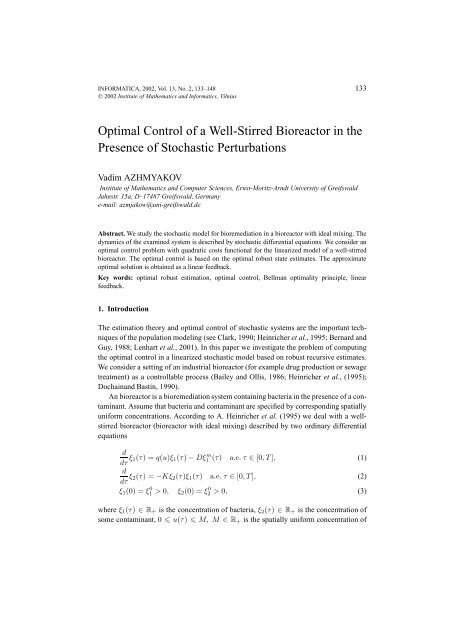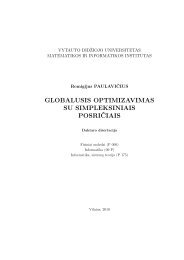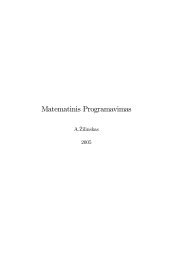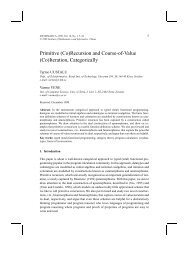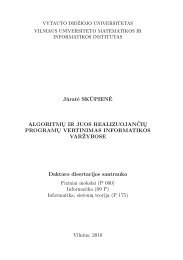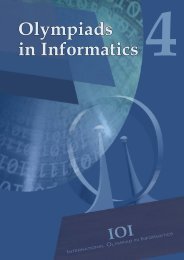Optimal Control of a Well-Stirred Bioreactor in the Presence of ...
Optimal Control of a Well-Stirred Bioreactor in the Presence of ...
Optimal Control of a Well-Stirred Bioreactor in the Presence of ...
Create successful ePaper yourself
Turn your PDF publications into a flip-book with our unique Google optimized e-Paper software.
INFORMATICA, 2002, Vol. 13, No. 2, 133–148 133<br />
© 2002 Institute <strong>of</strong> Ma<strong>the</strong>matics and Informatics, Vilnius<br />
<strong>Optimal</strong> <strong>Control</strong> <strong>of</strong> a <strong>Well</strong>-<strong>Stirred</strong> <strong>Bioreactor</strong> <strong>in</strong> <strong>the</strong><br />
<strong>Presence</strong> <strong>of</strong> Stochastic Perturbations<br />
Vadim AZHMYAKOV<br />
Institute <strong>of</strong> Ma<strong>the</strong>matics and Computer Sciences, Ernst-Moritz-Arndt University <strong>of</strong> Greifswald<br />
Jahnstr. 15a, D–17487 Greifswald, Germany<br />
e-mail: azmjakow@uni-greifswald.de<br />
Abstract. We study <strong>the</strong> stochastic model for bioremediation <strong>in</strong> a bioreactor with ideal mix<strong>in</strong>g. The<br />
dynamics <strong>of</strong> <strong>the</strong> exam<strong>in</strong>ed system is described by stochastic differential equations. We consider an<br />
optimal control problem with quadratic costs functional for <strong>the</strong> l<strong>in</strong>earized model <strong>of</strong> a well-stirred<br />
bioreactor. The optimal control is based on <strong>the</strong> optimal robust state estimates. The approximate<br />
optimal solution is obta<strong>in</strong>ed as a l<strong>in</strong>ear feedback.<br />
Key words: optimal robust estimation, optimal control, Bellman optimality pr<strong>in</strong>ciple, l<strong>in</strong>ear<br />
feedback.<br />
1. Introduction<br />
The estimation <strong>the</strong>ory and optimal control <strong>of</strong> stochastic systems are <strong>the</strong> important techniques<br />
<strong>of</strong> <strong>the</strong> population model<strong>in</strong>g (see Clark, 1990; He<strong>in</strong>richer et al., 1995; Bernard and<br />
Guy, 1988; Lenhart et al., 2001). In this paper we <strong>in</strong>vestigate <strong>the</strong> problem <strong>of</strong> comput<strong>in</strong>g<br />
<strong>the</strong> optimal control <strong>in</strong> a l<strong>in</strong>earized stochastic model based on robust recursive estimates.<br />
We consider a sett<strong>in</strong>g <strong>of</strong> an <strong>in</strong>dustrial bioreactor (for example drug production or sewage<br />
treatment) as a controllable process (Bailey and Ollis, 1986; He<strong>in</strong>richer et al., (1995);<br />
Docha<strong>in</strong>and Bast<strong>in</strong>, 1990).<br />
An bioreactor is a bioremediation system conta<strong>in</strong><strong>in</strong>g bacteria <strong>in</strong> <strong>the</strong> presence <strong>of</strong> a contam<strong>in</strong>ant.<br />
Assume that bacteria and contam<strong>in</strong>ant are specified by correspond<strong>in</strong>g spatially<br />
uniform concentrations. Accord<strong>in</strong>g to A. He<strong>in</strong>richer et al. (1995) we deal with a wellstirred<br />
bioreactor (bioreactor with ideal mix<strong>in</strong>g) described by two ord<strong>in</strong>ary differential<br />
equations<br />
d<br />
dτ ξ1(τ) =q(u)ξ1(τ) − Dξ m 1 (τ) a.e.τ ∈ [0,T], (1)<br />
d<br />
dτ ξ2(τ) =−Kξ2(τ)ξ1(τ) a.e.τ ∈ [0,T], (2)<br />
ξ1(0) = ξ 0 1 > 0, ξ2(0) = ξ 0 2 > 0, (3)<br />
where ξ1(τ) ∈ R+ is <strong>the</strong> concentration <strong>of</strong> bacteria, ξ2(τ) ∈ R+ is <strong>the</strong> concentration <strong>of</strong><br />
some contam<strong>in</strong>ant, 0 u(τ) M, M ∈ R+ is <strong>the</strong> spatially uniform concentration <strong>of</strong>
134 V. Azhmyakov<br />
a nutrient, D, m, K are known positive constants and a.e. means almost everywhere.<br />
The function u(·) plays <strong>the</strong> role <strong>of</strong> a control. We have a control process governed by<br />
equations (1) and (2) for 0
<strong>Optimal</strong> <strong>Control</strong> <strong>of</strong> a <strong>Well</strong>-<strong>Stirred</strong> <strong>Bioreactor</strong> <strong>in</strong> <strong>the</strong> <strong>Presence</strong> <strong>of</strong> Stochastic Perturbations 135<br />
The equation (5) is considered on <strong>the</strong> probability space (C([0,T], B,P)),whereP is <strong>the</strong><br />
measure appropriate to <strong>the</strong> stochastic differential equation<br />
dζ(τ) =b(τ)dw(τ).<br />
The (stochastic) state vector Y (τ) =(Y1(τ),Y2(τ)) ′ is <strong>the</strong> vector <strong>of</strong> <strong>the</strong> concentrations<br />
<strong>of</strong> bacteria and <strong>of</strong> contam<strong>in</strong>ant.<br />
It is well known that l<strong>in</strong>earization is an important tool for numerical methods <strong>of</strong> optimal<br />
control. Let q(·) be a cont<strong>in</strong>uously differentiable function. Us<strong>in</strong>g (5) we evaluate <strong>the</strong><br />
l<strong>in</strong>earized model <strong>of</strong> <strong>the</strong> bioreactor<br />
where<br />
and<br />
dY (τ) =(a1(τ)Y (τ)+a2(τ)u(τ))dt + b(τ)dw(τ), (6)<br />
Y (0) = ξ 0 , (7)<br />
a1(τ) := ∂<br />
∂Y ã(ξ∗ (τ),u ∗ (τ)) =<br />
a2(τ) := ∂<br />
∂u ã(ξ∗ (τ),u ∗ d<br />
(τ)) = dτ q(u∗ <br />
(τ))<br />
.<br />
0<br />
∗ ∗ q(u (τ)) − mD(ξ1 ) m−1 (τ) 0<br />
−Kξ∗ 2 (τ) −Kξ∗ 1 (τ)<br />
<br />
,<br />
The pair (ξ∗ (·),u∗ (·)), with ξ∗ (τ) :=(ξ∗ 1 (τ),ξ∗ 2 (τ))′ , is an optimal solution <strong>of</strong> <strong>the</strong> determ<strong>in</strong>istic<br />
optimal control problem (4) (see He<strong>in</strong>richer et al., 1995). The equation (6)<br />
is considered on <strong>the</strong> same probability space (C([0,T], B,P). Accord<strong>in</strong>g to <strong>the</strong> general<br />
existence results (Liptser and Shiryayev, 1977) we obta<strong>in</strong> <strong>the</strong> existence <strong>of</strong> <strong>the</strong> unique<br />
cont<strong>in</strong>uous solution Y (·) <strong>of</strong> <strong>the</strong> equation (6) for every admissible control function u(·).<br />
For <strong>the</strong> l<strong>in</strong>ear model (6)–(7) we formulate <strong>the</strong> follow<strong>in</strong>g stochastic optimal control<br />
problem with quadratic costs functional<br />
m<strong>in</strong>imize J(u) = 1<br />
2 E<br />
T<br />
[(Y<br />
0<br />
′ (τ),u(τ))Θ(τ)(Y ′ (τ),u(τ)) ′ <br />
]dτ<br />
(8)<br />
subject to (6) − (7), (9)<br />
where u(·) is <strong>the</strong> measurable control function such that 0 u(τ) M and Θ(τ) ∈<br />
R 3×3 . Now we present <strong>the</strong> follow<strong>in</strong>g existence <strong>the</strong>orem.<br />
Theorem 1. Let q(·) be a cont<strong>in</strong>uously differentiable function and b(·) be cont<strong>in</strong>uous.<br />
Then <strong>the</strong>re exists an optimal solution u(·) <strong>of</strong> (8)–(9).<br />
The pro<strong>of</strong> is found <strong>in</strong> Liptser and Shiryayev (1977). The Bellman’s equation for <strong>the</strong><br />
problem (8)–(9) may be written as<br />
<br />
∂<br />
m<strong>in</strong><br />
u∈U ∂τ S(τ,ξ)+〈a1(τ)ξ + a2(τ)u, ∂<br />
∂ξ 〉S(τ,ξ)
136 V. Azhmyakov<br />
+ 1<br />
<br />
b11(τ)<br />
2<br />
∂<br />
+ b22(τ)<br />
∂ξ1<br />
∂<br />
2 S(τ,ξ)+(ξ<br />
∂ξ2<br />
′ (τ),u(τ)) Θ(τ)(ξ ′ ′ <br />
(τ),u(τ))<br />
where ξ(τ) =(ξ1(τ),ξ2(τ)) ′ and S(·, ·) is <strong>the</strong> Bellman function.<br />
The rema<strong>in</strong>der <strong>of</strong> <strong>the</strong> paper is organized as follows. In Section 2 we deal with discretized<br />
optimal control problem <strong>in</strong> presence <strong>of</strong> non-Gaussian perturbations. In Section 3<br />
we formulate an auxiliary optimization problem for comput<strong>in</strong>g an optimal robust estimation<br />
and obta<strong>in</strong> a new m<strong>in</strong>imax robust estimator <strong>of</strong> <strong>the</strong> Kalman type. In <strong>the</strong> fourth Section<br />
we establish <strong>the</strong> conditional normality <strong>of</strong> <strong>in</strong>novations. In <strong>the</strong> fifth Section we present a<br />
solution <strong>of</strong> <strong>the</strong> discrete optimal control problem based on <strong>the</strong> obta<strong>in</strong>ed estimation and on<br />
<strong>the</strong> Bellman’s optimality pr<strong>in</strong>ciple.<br />
2. Problem Formulation<br />
In this section we <strong>in</strong>troduce a discrete-time approximat<strong>in</strong>g problem to <strong>the</strong> cont<strong>in</strong>uoustime<br />
optimal control problem (8)–(9). We consider <strong>the</strong> approximat<strong>in</strong>g problem under<br />
conditions <strong>of</strong> <strong>in</strong>complete <strong>in</strong>formation and extend <strong>the</strong> model under <strong>the</strong> assumption that <strong>the</strong><br />
state vector is observed.<br />
Let N be a sufficiently large positive <strong>in</strong>teger number and ∆τ := T/N be <strong>the</strong> fixed<br />
step size. We def<strong>in</strong>e <strong>the</strong> equidistant mesh {τ0, ..., τN }<br />
τ0 < ... < τN , τt = t∆τ,<br />
where t = 0, ..., N is <strong>the</strong> “discrete time”. Denote ˜ βt := Y (τt), ut := u(τt). Us<strong>in</strong>g<br />
Euler-type discretizations one can deduce <strong>the</strong> approximat<strong>in</strong>g state equation<br />
˜βt = ˜ Ft ˜ βt−1 + ˜ Htut +˜vt, (10)<br />
˜β0 = ξ 0 , t =1, ..., N, (11)<br />
where ˜ Ft := (I − ∆τa1(τt)) −1 , ˜ Ht := (I − ∆τa1(τt)) −1 a2(τt). We assume that<br />
<strong>the</strong> correspond<strong>in</strong>g matrices are <strong>in</strong>vertible. By ˜vt we denote here <strong>in</strong>dependent, identically<br />
distributed Gaussian random variables with values <strong>in</strong> R 2 such that<br />
E(˜vt) =0, E(˜vt˜v ′ s )= ˜ Qtδts, t,s =1, ..., N ,<br />
˜vt ∼N(E(˜vt), E(˜vt˜v ′ s )),<br />
where δts is <strong>the</strong> Kronecker delta and ˜ Q := b 2 (τt).<br />
In parallel with <strong>the</strong> state equation (10) we consider <strong>the</strong> l<strong>in</strong>ear observation model for<br />
<strong>the</strong> state vector ˜ β <strong>in</strong> (10)<br />
˜yt = ˜ Zt ˜ βt +˜ɛt, t =0, ..., N (12)<br />
where ˜ Zt ∈ R 2×2 ∀t =1, ..., N,and<br />
E(˜ɛt) =0, E(˜ɛt˜ɛ ′ s )= ˜ Vtδts, t,s =1, ..., N.
<strong>Optimal</strong> <strong>Control</strong> <strong>of</strong> a <strong>Well</strong>-<strong>Stirred</strong> <strong>Bioreactor</strong> <strong>in</strong> <strong>the</strong> <strong>Presence</strong> <strong>of</strong> Stochastic Perturbations 137<br />
Moreover, ˜vt are to be <strong>in</strong>dependent <strong>of</strong> any ˜ɛs for s t and, equally, ˜ɛt are <strong>in</strong>dependent <strong>of</strong><br />
any ˜vs for s t. Note that <strong>the</strong> assumption <strong>of</strong> l<strong>in</strong>ear observations is <strong>the</strong> characteristically<br />
assumption <strong>of</strong> <strong>the</strong> estimation <strong>the</strong>ory. This state-observation model f<strong>in</strong>ds wide application<br />
<strong>in</strong> <strong>the</strong> practice. Our goal is to estimate <strong>the</strong> state vector ˜ βt given observations ˜y1, ..., ˜yt.<br />
This estimates are bound to be optimal from <strong>the</strong> standpo<strong>in</strong>t <strong>of</strong> robustness. Us<strong>in</strong>g <strong>the</strong><br />
obta<strong>in</strong>ed robust estimate we will solve <strong>the</strong> follow<strong>in</strong>g optimal control problem<br />
N−1<br />
m<strong>in</strong>imize J := 1<br />
2 E<br />
<br />
(<br />
t=0<br />
˜ β ′ t ,ut)Θt( ˜ β ′ t ,ut)<br />
′<br />
(13)<br />
subject to (10) − (12), (14)<br />
where Θt := Θ(τt). Given <strong>the</strong> l<strong>in</strong>ear observation equation (12) <strong>the</strong> discrete optimal control<br />
problem (13)–(14) approximates <strong>the</strong> orig<strong>in</strong>al optimal control problem (8)–(9).<br />
3. <strong>Optimal</strong> Robust Estimation<br />
Now we exam<strong>in</strong>e <strong>the</strong> problem <strong>of</strong> optimal robust estimation <strong>of</strong> <strong>the</strong> state vector more generally.<br />
For t ∈ N let vt be <strong>in</strong>dependent, identically distributed (i.i.d.) random variables with<br />
values <strong>in</strong> R p , and, similarly, let ɛt ∈ R q be i.i.d.. These vt are to be <strong>in</strong>dependent <strong>of</strong> any<br />
ɛs for s t and, equally, ɛt <strong>in</strong>dependent <strong>of</strong> any vs for s t. Fur<strong>the</strong>rmore, let β0 be<br />
an <strong>in</strong>itial random variable <strong>in</strong> R p , <strong>in</strong>dependent <strong>of</strong> any vt, ɛt. Given some sequences <strong>of</strong><br />
matrices Ft ∈ R p×p and Zt ∈ R q×p for t ∈ N, we <strong>in</strong>troduce, aga<strong>in</strong> for t ∈ N, adiscrete<br />
dynamic system as<br />
where<br />
βt = Ftβt−1 + Htut + vt, (15)<br />
yt = Ztβt + ɛt, t ∈ N, (16)<br />
E(vt) =0, E(ɛt) =0,u0 =0, E(β0) =a0, E(β0β ′ <br />
0)=Q0,<br />
vt<br />
E ( v ′ k ɛ ′ k )=<br />
<br />
Qtδtk 0<br />
, k =1, 2, ...,<br />
ɛt<br />
0 Vtδtk<br />
and δtk is <strong>the</strong> Kronecker delta. Let Ht ∈ R p×m .Byut ∈ R m ,t∈ N we denote a control<br />
vector. The matrices Ft, Zt, Ht, Qt, Vt are supposed to be known. Let us consider <strong>the</strong><br />
follow<strong>in</strong>g optimal control problem<br />
N−1<br />
<br />
At Bt<br />
<br />
(β ′ t,u ′ t) ′ + β ′ <br />
N PN βN<br />
m<strong>in</strong>imize J := 1<br />
2 E (β<br />
t=0<br />
′ t,u ′ t)<br />
B ′ t Ct<br />
(17)<br />
subject to (15) − (16), (18)
138 V. Azhmyakov<br />
where PN ,At ∈ R p×p , Bt ∈ R p×m , Ct ∈ R m×m . Under <strong>the</strong> usual assumptions <strong>of</strong><br />
normality β0 ∼N(a0,Q0), vt ∼N(0,Qt), ɛt ∼N(0,Vt), <strong>the</strong> solution <strong>of</strong> (17)–(18) is<br />
given <strong>in</strong> <strong>the</strong> form <strong>of</strong> l<strong>in</strong>ear feedback (Bryson and Ho, 1975)<br />
u ∗ t = −k 1 t β 0 t|t , t =1, ..., N<br />
where k 1 t is an amplification factor and β0 t|t := E(βt|y ∗ t ), y∗ t := (y ′ 1 , ..., y′ t )′ is <strong>the</strong><br />
Kalman estimate <strong>of</strong> <strong>the</strong> vector βt.<br />
It is well known that Kalman filter<strong>in</strong>g is one <strong>of</strong> <strong>the</strong> most important developments <strong>of</strong><br />
<strong>the</strong> l<strong>in</strong>ear estimation <strong>the</strong>ory. It is a useful <strong>in</strong>strument for recursively treat<strong>in</strong>g <strong>of</strong> controllable<br />
dynamic systems (Anderson and Moore, 1979; Bryson and Ho, 1975; Polyak and<br />
Tsypk<strong>in</strong>, 1979). The Kalman recursion is widely used for control <strong>of</strong> discrete stochastic<br />
systems (Bryson and Ho, 1975; Polyak and Tsypk<strong>in</strong>, 1979; Liptser and Shiryayev, 1977).<br />
The standard Kalman filter is given by <strong>the</strong> follow<strong>in</strong>g recursion.<br />
• Initial step:<br />
• Prediction:<br />
β 0 0|0 = a0, Σ 0 0|0 = Q0.<br />
β 0 t|t−1 = Ftβ 0 t−1|t−1 + Htut−1,<br />
Σ 0 t|t−1 = FtΣ 0 t−1|t−1 F ′ t + Qt, t ∈ N<br />
where β 0 t|t−1 =E(βt|y ∗ t−1 ), Σ0 t|t−1 =Cov(βt − β 0 t|t−1 ), Σ0 t|t =Cov(βt − β 0 t|t ).<br />
• Correction:<br />
β 0 t|t = β0 t|t−1 + ˆ Mt(yt − Ztβ 0 t|t−1 ),<br />
Σ 0 t|t =Σ0t|t−1 − ˆ MtZtΣ 0 t|t−1 ,<br />
where ˆ Mt =Σ 0 t|t−1 Z′ t [ZtΣ 0 t|t−1 Z′ t + Vt] −1 .<br />
The Kalman filter assures optimal least-squares estimation <strong>of</strong> a process only under <strong>the</strong><br />
assumption that <strong>the</strong> random perturbations are Gaussian (Anderson and Moore, 1979). If,<br />
however, <strong>the</strong> measurement or state errors conta<strong>in</strong> outliers, a Kalman filter estimator may<br />
be quite <strong>in</strong>accurate. The correspond<strong>in</strong>g solution <strong>of</strong> <strong>the</strong> optimal control problem (17)–(18)<br />
can be ill-def<strong>in</strong>ed. Therefore, we use a robust version <strong>of</strong> <strong>the</strong> Kalman filter for effective<br />
solv<strong>in</strong>g <strong>the</strong> optimal control problem (17)–(18) <strong>in</strong> <strong>the</strong> non-Gaussian case.<br />
Assume that β0 ∼ G0(a0,Q0) and E(β0) =a0, E(β0β ′ 0)=Q0, whereG0 is a<br />
distribution function <strong>of</strong> β0.Let<br />
ɛt ∼ G ∈P(0,Wt) :=<br />
<br />
G |<br />
Rq <br />
ɛtG(dɛt) =0,<br />
Rq ɛtɛ ′ tG(dɛt) <br />
Wt < ∞
and<br />
<strong>Optimal</strong> <strong>Control</strong> <strong>of</strong> a <strong>Well</strong>-<strong>Stirred</strong> <strong>Bioreactor</strong> <strong>in</strong> <strong>the</strong> <strong>Presence</strong> <strong>of</strong> Stochastic Perturbations 139<br />
vt ∼ G ∈P(0,Rt) :=<br />
<br />
G |<br />
Rp <br />
vtG(dvt) =0,<br />
Rp vtv ′ tG(dvt) <br />
Rt < ∞ ,<br />
where Wt, Rt are symmetric, positive semi-def<strong>in</strong>ite matrices, and G is a distribution <strong>of</strong><br />
vector ɛt or vt. For <strong>the</strong> sequel let us <strong>in</strong>troduce <strong>the</strong> expressions<br />
∆βt := βt − βt|t−1, βt|t−1 := E[βt|y ∗ t−1 ],<br />
∆yt := yt − E[yt|y ∗ t−1 ], t =1, 2, ...,<br />
and note that ∆β1 = F1(β0 − a0) +v1, ∆yt = Zt∆βt + ɛt. The random variables<br />
∆βt, t=1, 2, ... are called <strong>in</strong>novations. By xt we denote <strong>the</strong> vector (∆β ′ t , ∆y′ t )′ with<br />
covariance matrix<br />
Cov(xt) =<br />
Σt|t−1 Σ t|t−1Z ′ t<br />
ZtΣ t|t−1 ZtΣ t|t−1Z ′ t + Vt<br />
Suppose that Cov(xt) St < ∞,whereSt is a symmetric, positive semi-def<strong>in</strong>ite matrix.<br />
Here <strong>the</strong> purpose is to estimate <strong>the</strong> state βt given observations y ∗ t . The correspond<strong>in</strong>g<br />
estimate will be called β t|t. Us<strong>in</strong>g this estimate we solve <strong>the</strong> optimal control problem<br />
(17)–(18). The desired estimate β t|t must be def<strong>in</strong>ed as a robust estimate.<br />
A formal def<strong>in</strong>ition <strong>of</strong> robustness can be found <strong>in</strong> Huber (1981). We assume that <strong>the</strong><br />
observed data is contam<strong>in</strong>ated. One <strong>of</strong> <strong>the</strong> most frequent types <strong>of</strong> contam<strong>in</strong>ated data is<br />
ɛ-contam<strong>in</strong>ated normal data with distribution<br />
G =(1− ς)N (a, σ)+ςH, 0 ς 1,<br />
where H is a symmetric distribution. Note that <strong>the</strong> sets P(0,Wt) and P(0,Rt) don’t specify<br />
any topological neighborhood <strong>in</strong> <strong>the</strong> space <strong>of</strong> distributions (Huber, 1971). In practice,<br />
however, contam<strong>in</strong>ated data is <strong>of</strong>ten described with help <strong>of</strong> <strong>the</strong> sets P(0,Wt), P(0,Rt).<br />
We use <strong>the</strong> follow<strong>in</strong>g concept: an estimator is robust if it rema<strong>in</strong>s f<strong>in</strong>ite as one or more <strong>of</strong><br />
<strong>the</strong> data po<strong>in</strong>ts become arbitrarily large.<br />
Let<br />
<br />
Φ:= gt : Z+ × R q → R p<br />
<br />
<br />
<br />
gt is a measurable function .<br />
<br />
.<br />
Now let us formulate <strong>the</strong> follow<strong>in</strong>g auxiliary m<strong>in</strong>imax problem<br />
sup<br />
P(0,St)<br />
P(0,St) :=<br />
E||∆βt − gt(∆yt)∆yt|| 2 → m<strong>in</strong>!,<br />
(19)<br />
gt∈Φ<br />
<br />
G |<br />
Rp+q xtG(dxt) =0,<br />
<br />
R p+q<br />
xtx ′ <br />
tG(dxt) St < ∞ ,<br />
where G is a distribution <strong>of</strong> vector xt. We call <strong>the</strong> function gt(∆yt) ∈ Φ a weight function.<br />
Expression (19) def<strong>in</strong>es a weighted least-squares estimate for ∆βt. If a solution <strong>of</strong>
140 V. Azhmyakov<br />
<strong>the</strong> optimization problem (19) exists <strong>the</strong>n we also can get an estimate β t|t <strong>of</strong> <strong>the</strong> vector<br />
βt as a recursive weighted least-squares estimate. We call this estimate <strong>the</strong> optimal robust<br />
estimate <strong>of</strong> vector βt. This estimate is a weighted least squares estimate <strong>of</strong> ∆βt. Note<br />
that <strong>the</strong> weighted least squares method is one <strong>of</strong> <strong>the</strong> most popular algorithms for calculat<strong>in</strong>g<br />
robust estimators (Huber, 1981; Cipra and Romera, 1991; Bosov and Pankov, 1992;<br />
Fahrmeir and Kaufmann, 1991; Pupeikis, 1998; Azhmyakov, 2000).<br />
REMARK 1. The classical Kalman filter is <strong>the</strong> solution <strong>of</strong> <strong>the</strong> problem<br />
E||∆β 0 t − Mt∆y 0 t || 2 → m<strong>in</strong>!,<br />
Mt<br />
Mt ∈ R p×q , t ∈ N,<br />
under <strong>the</strong> usual assumptions <strong>of</strong> normality. The weight function is equal to Mt. It is evident<br />
that this problem is analogous to (19).<br />
Let<br />
<br />
S11 S12<br />
St :=<br />
S21 S22<br />
<br />
.<br />
We assume that S22 is an <strong>in</strong>vertible matrix. Now we present our ma<strong>in</strong> result relative<br />
to <strong>the</strong> optimal robust estimate.<br />
Theorem 2. Suppose that E(ut|y ∗ t ) = ut, t ∈ N. The problem (19) has an unique<br />
solution and <strong>the</strong> optimal robust estimate β t|t <strong>of</strong> <strong>the</strong> vector βt is given by <strong>the</strong> recursions<br />
βt|t = βt|t−1 + g opt<br />
t (∆yt)∆yt, β0|0 = a0, (20)<br />
βt|t−1 = Ftβt−1|t−1 + Htut, (21)<br />
g opt<br />
t (∆yt) =S12S −1<br />
22 , t ∈ N. (22)<br />
Pro<strong>of</strong>. First let x 0 t ∼N(0,S0 t ),S0 t St, where<br />
S 0 t =<br />
0 Σt|t−1 Σ0 t|t−1Z′ t<br />
ZtΣ0 t|t−1 ZtΣ0 t|t−1Z′ t + Vt<br />
Then <strong>the</strong> follow<strong>in</strong>g relation<br />
<br />
.<br />
E||∆β 0 t − g0 t (∆y0 t )∆y0 t ||2 =m<strong>in</strong><br />
gt∈Φ E||∆β0 t − gt(∆y 0 t )∆y0 t ||2<br />
is satisfied, where<br />
g 0 t (∆y0 t ):= ˆ Mt =Σ 0 t|t−1Z′ t (ZtΣ 0 t|t−1Z′ t + Vt) −1 ,<br />
g 0 t (∆y0 t )∆y0 t =E[∆β0 t |y∗ t ],
and g 0 t<br />
<strong>Optimal</strong> <strong>Control</strong> <strong>of</strong> a <strong>Well</strong>-<strong>Stirred</strong> <strong>Bioreactor</strong> <strong>in</strong> <strong>the</strong> <strong>Presence</strong> <strong>of</strong> Stochastic Perturbations 141<br />
∈ Φ. Let<br />
J(S 0 t ):=E||∆β 0 t − g 0 t (∆y 0 t )∆y 0 t || 2 .<br />
Hence J(S 0 t ) = tr(Σ0 t|t ). Now we consider a vector xt ∼ G ∈P(0,St). Then for all<br />
gt ∈ Φ, such that E||gt(∆yt)∆yt|| 2 < ∞ <strong>the</strong> <strong>in</strong>equality<br />
sup E||∆βt − gt(∆yt)∆yt||<br />
P(0,St)<br />
2 E||∆β 0 t − gt(∆y 0 t )∆y 0 t || 2<br />
m<strong>in</strong><br />
gt∈Φ E||∆β0 t − gt(∆y 0 t )∆y0 t ||2 =E||∆β 0 t − g0 t (∆y0 t )∆y0 t ||2 = J(S 0 t )<br />
is satisfied. For all S 0 t St we obta<strong>in</strong> <strong>the</strong> <strong>in</strong>equality<br />
m<strong>in</strong><br />
gt∈Φ sup E||∆βt − gt(∆yt)∆yt||<br />
P(0,St)<br />
2<br />
m<strong>in</strong><br />
gt∈Φ E||∆β0 t − gt(∆y 0 t )∆y0 t ||2 = J(S 0 t ).<br />
Let us take <strong>the</strong> matrix ˜ S0 := argmaxS0 t StJ(S0 t ) as S0 t . Denote<br />
where<br />
˜J := sup<br />
S0 t St<br />
J(S 0 t ),<br />
Σ 0 t|t S11 − S12S −1<br />
22 S21.<br />
Evidently <strong>the</strong> trace tr(Σ 0 t|t ) <strong>of</strong> matrix Σ0 t|t is a non-decreas<strong>in</strong>g function (<strong>the</strong> matrix Σ0 t|t<br />
is a positive semi-def<strong>in</strong>ite matrix). Therefore ˜ S 0 = St and<br />
˜J = J(St).<br />
Now <strong>in</strong>equality (23) can be written as<br />
where<br />
m<strong>in</strong><br />
gt∈Φ sup E||∆βt − gt(∆yt)∆yt||<br />
P(0,St)<br />
2 ˜ J, (24)<br />
˜J =tr(Cov(∆β 0 t − ˜gt(∆y 0 t )∆y 0 t )) = tr(S11 − S12S −1<br />
22 S21),<br />
˜gt(∆y 0 t ):=S12S −1<br />
22 .<br />
It is obvious that ˜gt ∈ Φ.<br />
For <strong>the</strong> vector xt ∼ G ∈P(0,St) with a covariance matrix Cov(xt) St we get<br />
E||∆βt−g 0 t (∆yt)∆yt|| 2 =tr(Σ t|t−1−Σ t|t−1Z ′ t (ZtΣ t|t−1Z ′ t +Vt)ZtΣ t|t−1)<br />
= J(S 0 t ).<br />
(23)
142 V. Azhmyakov<br />
Hence<br />
and<br />
sup E||∆βt − g<br />
P(0,St)<br />
0 t (∆yt)∆yt|| 2 = sup tr(Σt|t) P(0,St)<br />
= sup<br />
Cov(xt)St<br />
J(Cov(xt)) = J(St) = ˜ J, (25)<br />
sup tr(Σt|t) =E||∆βt − ˜gt(∆yt)∆yt||<br />
P(0,St)<br />
2 . (26)<br />
From (25) and (26) it follows that <strong>the</strong> <strong>in</strong>equality<br />
m<strong>in</strong><br />
gt∈Φ sup E||∆βt − gt(∆yt)∆yt||<br />
P(0,St)<br />
2<br />
sup E||∆βt − ˜gt(∆yt)∆yt||<br />
P(0,St)<br />
2 = sup tr(Σt|t) =<br />
P(0,St)<br />
˜ J (27)<br />
is satisfied.<br />
From relations (24) and (27) we get <strong>the</strong> relation (22)<br />
g opt<br />
t<br />
−1<br />
= S12S22 .<br />
The normal equation for (∆βt − gt(∆yt)∆yt) implies <strong>the</strong> formulae (20) and (21) for β t|t<br />
and β t|t−1.Letβ 0|0 = β0. The <strong>the</strong>orem is proved.<br />
COROLLARY 1. The relations for covariance matrices Σ t|t−1 := Cov(β−β t|t−1) and<br />
Σ t|t := Cov(βt − β t|t) are given by <strong>the</strong> follow<strong>in</strong>g recursions<br />
Σt|t−1 = FtΣt−1|t−1F ′ t + Qt, (28)<br />
Σt|t =Σt|t−1−Σt|t−1L ′ t−LtΣ t|t−1+LtΣ t|t−1L ′ −1 −1<br />
t +S12S22 VtS22 S′ 12 , (29)<br />
where Σ 0|0 = Q0 and Lt := S12S −1<br />
22 Zt, t∈ N.<br />
This corollary can be proved by direct calculations.<br />
The formulae (20)–(22) and (28)–(29) def<strong>in</strong>e <strong>the</strong> optimal (<strong>in</strong> <strong>the</strong> sense <strong>of</strong> <strong>the</strong> problem<br />
(19)) robust estimate <strong>of</strong> <strong>the</strong> vector βt. As we can see <strong>the</strong> estimate β t|t has <strong>the</strong> structure <strong>of</strong><br />
<strong>the</strong> classical Kalman filter.<br />
4. Some Properties <strong>of</strong> <strong>the</strong> <strong>Optimal</strong> Robust Estimate<br />
In this section we show that <strong>the</strong> conditional density <strong>of</strong> <strong>the</strong> optimal robust estimate (20)–<br />
(22) is a Gaussian density. The obta<strong>in</strong>ed estimation has a form <strong>of</strong> “weighted” recursion<br />
β t|t = β t|t−1 + wt(∆yt)∆yt, β 0|0 = a0, (30)
<strong>Optimal</strong> <strong>Control</strong> <strong>of</strong> a <strong>Well</strong>-<strong>Stirred</strong> <strong>Bioreactor</strong> <strong>in</strong> <strong>the</strong> <strong>Presence</strong> <strong>of</strong> Stochastic Perturbations 143<br />
∆yt := yt − E(yt|y ∗ t−1 )=Zt∆βt + ɛt, (31)<br />
βt|t−1 = Ftβt−1|t−1 + Htut, (32)<br />
t ∈ N,<br />
where wt(∆yt) =g opt<br />
t (∆yt). Many famous variants <strong>of</strong> robust Kalman filter have <strong>the</strong><br />
same structure <strong>of</strong> “weighted” recursion (Fahrmeir and Kaufmann, 1991; Bosov and<br />
Pankov, 1992; Cipra and Romera, 1991; Azhmyakov, 2000).<br />
Let {Ω, F,P} be a probability space <strong>of</strong> <strong>the</strong> processes yt and ∆yt. ByF yt<br />
t and F ∆yt<br />
t<br />
we denote σ-algebras generated by yt and ∆yt respectively.<br />
Lemma 1. For <strong>the</strong> processes yt and ∆yt def<strong>in</strong>ed by formulae (16) and (31) <strong>the</strong> equality<br />
F yt<br />
t = F ∆yt<br />
t , ∀t >1<br />
is satisfied.<br />
Pro<strong>of</strong>. By def<strong>in</strong>ition we have ∆yt = yt − Ztβ t|t−1. The functions β t|t−1 and ∆yt, t>1<br />
are measurable functions <strong>of</strong> <strong>the</strong> vector (y ′ 1 , ...y′ t−1 )′ . Hence<br />
F ∆yt<br />
t<br />
⊆F yt<br />
t , ∀t >1.<br />
From (30)–(32) it follows that ∀t >1 <strong>the</strong> stochastic function<br />
yt =∆yt + ZtFtβ t|t−1<br />
is a F yt<br />
t -measurable function. F<strong>in</strong>ally we obta<strong>in</strong> F yt<br />
t ⊆F ∆yt<br />
t<br />
Now we consider <strong>the</strong> follow<strong>in</strong>g recursions for <strong>in</strong>novations<br />
∆βt+1 = Ft+1(I − wt(∆yt)Zt)∆βt − Ft+1wt(∆yt)ɛt + vt+1, t 0.<br />
Let v1 ∼N(0,Q1), ɛ1∼N(0,V1). We assume that <strong>the</strong>re exists a conditional density<br />
) <strong>of</strong> <strong>the</strong> vector ∆βt.<br />
function p(∆βt|F ∆yt<br />
t<br />
Theorem 3. The conditional density function p(∆βt|F ∆yt<br />
t ), t∈ N is a Gaussian density<br />
function<br />
Pro<strong>of</strong>. The pro<strong>of</strong> is by <strong>in</strong>duction on t.<br />
For t =1we obta<strong>in</strong><br />
∆β1 = F1(β0 − a0)+v1,<br />
∆y1 = Z1F1(β0 − a0)+Z1v1 + ɛ1,<br />
.
144 V. Azhmyakov<br />
and<br />
(∆β1, ∆y1) ′ ∼Np+q<br />
It follows that<br />
P (∆β1 χ |F ∆y1<br />
)<br />
<br />
0,<br />
F1Q0F ′ 1 +Q1 (F1Q0F ′ 1 +Q1)Z ′ 1<br />
Z1(F1Q0F ′ 1 +Q1) Z1(F1Q0F ′ 1 +Q1)Z ′ 1 +V1<br />
1<br />
<br />
0+(F1Q0F ′ 1 +Q1)Z ′ 1 (Z1(F1Q0F ′ 1 +Q1)Z ′ 1 +V1) − × (∆y1 − 0),<br />
(F1Q0F ′ 1+Q1)−(F1Q0F ′ 1+Q1)Z ′ 1(Z1(F1Q0F ′ 1+Q1)Z ′ 1+V1) −<br />
=Np<br />
×Z1(F1Q0F ′ 1 +Q1) ,<br />
<br />
.<br />
where χ ∈ Rp .<br />
Let P (∆βs χ |F∆ys s )=Np(ms, γs). We use <strong>the</strong> Lemma 1 and consider <strong>the</strong><br />
follow<strong>in</strong>g conditional distribution function P (∆βs χ |Fys s )=Np(ms, γs). Thenwe<br />
have<br />
where<br />
P (∆βs+1 χ, ∆ys+1 ϕ | ∆βs, F ys<br />
s )=N (A, B), ϕ ∈ R q ,<br />
A =(c1,c2) ′ =<br />
Fs+1<br />
Zs+1Fs+1<br />
= A1∆βs − A2(∆ys),<br />
c1 ∈ R p , c2∈R q ,<br />
and <strong>the</strong> covariance matrix B is equal to<br />
<br />
Qs+1<br />
B =<br />
0<br />
<br />
.<br />
0 Vs+1<br />
<br />
<br />
Fs+1ws(∆ys)<br />
∆βs −<br />
∆ys<br />
Zs+1Fs+1ws(∆ys)<br />
Note that (∆βs+1 − c1) =vs+1, (∆ys+1 − c2) =ɛs+1.<br />
Now we consider <strong>the</strong> characteristic function <strong>of</strong> <strong>the</strong> vector (∆ ′ βs+1, ∆ ′ ys+1) ′<br />
E(exp(iλ ′ (∆ ′ βs+1, ∆ ′ ys+1) ′ )|∆βs, F ys<br />
s )<br />
=exp[iλ ′ (A1∆βs − A2(∆ys)) − 0.5λ ′ Bλ], λ ∈ R p+q .<br />
By <strong>in</strong>duction step we obta<strong>in</strong><br />
E(exp(iλ ′ A1∆βs)|F ys<br />
s )=exp[iλ′ A1ms − 0.5λ ′ A1γsA ′ 1 λ].<br />
Therefore <strong>the</strong> relation<br />
E(exp(iλ ′ (∆ ′ βs+1, ∆ ′ ys+1) ′ )|F ys<br />
s )<br />
=exp iλ ′ (A1ms − A2(∆ys)) − 0.5λ ′ (B + A1γsA ′ 1 )λ ,
and<br />
<strong>Optimal</strong> <strong>Control</strong> <strong>of</strong> a <strong>Well</strong>-<strong>Stirred</strong> <strong>Bioreactor</strong> <strong>in</strong> <strong>the</strong> <strong>Presence</strong> <strong>of</strong> Stochastic Perturbations 145<br />
P (∆βs+1 χ, ∆ys+1 ϕ |F ys<br />
s )=N(A1ms − A2(∆ys), B+ A1γsA ′ 1 ),<br />
ϕ ∈ R q<br />
are satisfied. It follows that <strong>the</strong> conditional distribution function<br />
P ∆βs+1 χ |F ys+1<br />
s+1<br />
is also Gaussian distribution function (Liptser and Shiryayev, 1977).<br />
Thus <strong>the</strong> <strong>in</strong>novations ∆βt, t=1, 2, ... are conditionally normal random variables. By<br />
mt and γt, t∈ N we denote <strong>the</strong> conditional expectation and <strong>the</strong> conditional covariance<br />
matrix <strong>of</strong> <strong>the</strong> process ∆βt. It is evident that<br />
m1 =(F1Q0F ′ 1 + Q1)Z ′ 1 (Z1(F1Q0F ′ 1 + Q1)Z ′ 1 + V1) − ∆y1,<br />
+ Q1)<br />
γ1 =(F1Q0F ′ 1<br />
− (F1Q0F ′ 1 + Q1)Z ′ 1(Z1(F1Q0F ′ 1 + Q1)Z ′ 1 + V1) − Z1(F1Q0F ′ 1 + Q1).<br />
COROLLARY 2. For <strong>the</strong> parameters mt and γt <strong>of</strong> <strong>the</strong> density function p(∆βt|F yt<br />
t ) <strong>the</strong><br />
follow<strong>in</strong>g relations<br />
mt+1 = (Ft+1 − Ξt+1Zt)mt − Ξt+1∆y 0 t<br />
+Υt+1(∆yt+1 − Zt+1((Ft+1 − Ξt+1Zt)mt − Ξt+1∆y 0 t )), (33)<br />
γt+1 = (Ft+1γtF ′ t+1 + Qt+1) − Υt+1Zt+1(Ft+1γtF ′ t+1 + Qt+1), (34)<br />
Υt+1 = (Ft+1γtF ′ t+1 + Qt+1)Z ′ t+1 × [Zt+1(Ft+1γtFt+1 + Qt+1)Z ′ t+1 + Vt+1] − ,<br />
Ξt+1 := Ft+1wt(∆yt), t ∈ N<br />
are satisfied.<br />
Pro<strong>of</strong>. We have<br />
where<br />
and<br />
mt+1 =E(∆βt+1|F yt<br />
t )+Υt+1(∆yt+1 − E(∆yt+1|F yt<br />
t )),<br />
γt+1 = d1 − Υt+1d2,<br />
d1 := Cov(∆βt+1|F yt<br />
t ),<br />
d2 := Cov(∆yt+1, ∆βt+1|F yt<br />
t ),<br />
Υt+1 =Cov(∆βt+1, ∆yt+1|F yt<br />
yt<br />
t )Cov(∆yt+1|Ft )− .
146 V. Azhmyakov<br />
Thus we obta<strong>in</strong> <strong>the</strong> formula<br />
mt+1 =(Ft+1 − Ξt+1Zt)mt − Ξt+1∆y 0 t<br />
t ∈ N.<br />
+Υt+1(∆yt+1 − Zt+1((Ft+1 − Ξt+1Zt)mt − Ξt+1∆y 0 t )),<br />
For <strong>the</strong> vectors ∆βt and ∆yt <strong>the</strong> follow<strong>in</strong>g relations<br />
∆βt+1 − E(∆βt+1|F yt<br />
t )=Ft+1(∆βt − mt)+vt+1,<br />
∆yt+1 − E(∆yt+1|F yt<br />
t )=Zt+1Ft+1(∆βt − mt)+Zt+1vt+1 + ɛt+1,<br />
are satisfied.<br />
Now we calculate <strong>the</strong> covariance matrices d1 and d2<br />
d1 = Ft+1γtF ′ t+1 + Qt+1,<br />
d2 = Zt+1(Ft+1γtF ′ t+1 + Qt+1),<br />
Υt+1 = d ′ 2(Zt+1(Ft+1γtF ′ t+1 + Qt+1)Z ′ t+1 + Vt+1) − ,<br />
and at last we obta<strong>in</strong> <strong>the</strong> formulae (33)–(34).<br />
The conditionally normality <strong>of</strong> <strong>the</strong> vectors ∆βt makes possible more detailed <strong>in</strong>vestigation<br />
<strong>of</strong> <strong>the</strong> robust estimate (20)–(22).<br />
5. <strong>Optimal</strong> L<strong>in</strong>ear Feedback<br />
For solv<strong>in</strong>g <strong>the</strong> optimal control problems (17)–(18) and (13)–(14) for t =1, ..., N we<br />
use <strong>the</strong> optimal robust estimate given by formulae (20)–(22). First let us consider <strong>the</strong><br />
problem (17)–(18). We construct <strong>the</strong> optimal control ut as a l<strong>in</strong>ear function <strong>of</strong> <strong>the</strong> vector<br />
β t|t (l<strong>in</strong>ear feedback) (Bryson and Ho, 1975) namely<br />
u ∗ t = −k2 t β t|t, t=1, ..., N, (35)<br />
where <strong>the</strong> matrix k 2 t is equal to<br />
k 2 t =(H′ tPt+1Ht + Ct) −1 (H ′ tPt+1Ft + B ′ t ), (36)<br />
Pt = F ′ tPt+1Ft − (k 2 t )′ (Ct + H ′ tPt+1Ht)k 2 t + At. (37)<br />
The matrix PN is given. The optimal robust estimate (20)–(22) has <strong>the</strong> structure <strong>of</strong> <strong>the</strong><br />
classical Kalman filter. Therefore us<strong>in</strong>g <strong>the</strong> optimality pr<strong>in</strong>ciple <strong>of</strong> Bellman one can prove<br />
(Bryson and Ho, 1975) that <strong>the</strong> optimal control function has <strong>the</strong> form <strong>of</strong> <strong>the</strong> l<strong>in</strong>ear feedback<br />
(35).<br />
The formulae for <strong>the</strong> optimal robust estimate (20)–(22), <strong>the</strong> recursions for covariance<br />
matrices (28)–(29) and relations (36)–(37) completely determ<strong>in</strong>e <strong>the</strong> solution (35) <strong>of</strong> <strong>the</strong>
<strong>Optimal</strong> <strong>Control</strong> <strong>of</strong> a <strong>Well</strong>-<strong>Stirred</strong> <strong>Bioreactor</strong> <strong>in</strong> <strong>the</strong> <strong>Presence</strong> <strong>of</strong> Stochastic Perturbations 147<br />
problem (17)–(18). This solution is robust with respect to stochastic perturbations (outliers).<br />
It is evident that <strong>the</strong> condition E(ut|y ∗ t )=ut, t=1, 2, ..., N <strong>of</strong> <strong>the</strong> Theorem 2 is<br />
also satisfied.<br />
The covariance matrix Σ t|t−1 satisfies <strong>the</strong> algebraic Riccati equation (Anderson and<br />
Moore, 1979)<br />
Σ t+1|t = Ft(Σ t|t−1 − Σ t|t−1Z ′ t[ZtΣ t|t−1Z ′ t + Vt] −1 ZtΣ t|t−1)F ′ t + Qt.<br />
Now we use <strong>the</strong> presented <strong>the</strong>ory <strong>of</strong> <strong>the</strong> optimal robust estimation <strong>in</strong> <strong>the</strong> discrete<br />
optimal control problem <strong>of</strong> a bioreactor (13)–(14). Consider <strong>the</strong> model (10)–(12). It was<br />
assumed that<br />
and<br />
˜ɛt ∼ G ∈P(0,Wt) :=<br />
˜vt ∼ G ∈P(0,Rt) :=<br />
For <strong>the</strong> problem (13)–(14) we have PN ≡ 0 and<br />
Let<br />
<br />
G |<br />
R2 <br />
˜ɛtG(d˜ɛt) =0,<br />
R2 ˜ɛt˜ɛ ′ tG(d˜ɛt) <br />
Wt < ∞ ,<br />
<br />
G |<br />
R2 <br />
˜vtG(d˜vt) =0,<br />
R2 ˜vt˜v ′ tG(d˜vt) <br />
Rt < ∞ .<br />
˜Ft := (I − ∆τa1(τt)) −1 , ˜ Ht := (I − ∆τa1(τt)) −1 a2(τt).<br />
Θt =<br />
⎛<br />
⎝<br />
θ11 θ12 θ13<br />
θ21 θ22 θ23<br />
θ31 θ32 θ33<br />
The optimal solution u opt<br />
t<br />
<strong>in</strong>g relations<br />
where<br />
⎞<br />
⎠ .<br />
<strong>of</strong> <strong>the</strong> approximat<strong>in</strong>g problem (13)–(14) is given by follow-<br />
u opt<br />
t = −k3 t ˜ βt|t, t =1, ..., N , (38)<br />
k 3 t = ˜ H ′ tPt+1 ˜ Ft +(θ31,θ32)<br />
˜H ′ tPt+1 ˜ ,<br />
Ht + θ33<br />
(39)<br />
Pt = ˜ F ′ tPt+1Ft − (k 3 t ) ′ (θ33 + ˜ H ′ tPt+1 ˜ H)k 3 t + Ãt, (40)<br />
PN =0, (41)<br />
<br />
θ11 θ12<br />
Ãt :=<br />
θ21 θ22<br />
<br />
.<br />
The vector ˜ β t|t is def<strong>in</strong>ed by <strong>the</strong> recursions (20)–(22) and (28)–(29). These recursions<br />
and <strong>the</strong> formulae (38)–(41) completely def<strong>in</strong>e <strong>the</strong> optimal solution <strong>of</strong> <strong>the</strong> discrete optimal
148 V. Azhmyakov<br />
control problem (13)–(14). The solution <strong>of</strong> <strong>the</strong> optimal control problem problem (13)–<br />
(14) is given by l<strong>in</strong>ear feedback (38).<br />
Acknowledgements: The author is grateful to Pr<strong>of</strong>essor P.J. Huber for his helpful<br />
comments and suggestions.<br />
References<br />
Anderson, B.O, J.B. Moore (1979). <strong>Optimal</strong> Filter<strong>in</strong>g. Prentice–Hall, Inc., Englewood Clifs, New Jersey.<br />
Azhmyakov, V. (2000). M<strong>in</strong>imax robust estimation and control <strong>in</strong> stochastic systems. Stability and <strong>Control</strong>:<br />
Theory and Appl., 3, 253–262.<br />
Bailey, J., D. Ollis (1986). Biochemical Eng<strong>in</strong>eer<strong>in</strong>g Fundamentals. McGraw–Hill, New York.<br />
Bernard, M., P. Guy (1988). Parameters estimation <strong>of</strong> an aquatic biological system by <strong>the</strong> adjo<strong>in</strong>t method. Math.<br />
and Comput. Simul., 30, 405–418.<br />
Bosov, A.V., A.R. Pankov (1992). Robust recursive estimation <strong>of</strong> processes <strong>in</strong> stochastic systems. Avtomat. i<br />
Telemekh., 9, 102–110 (<strong>in</strong> Russian).<br />
Bryson, A.E., J.C. Ho (1975). Applied <strong>Optimal</strong> <strong>Control</strong>. J. Wiley, New York.<br />
Cipra, T., R. Romera (1991). Robust Kalman filter and its application <strong>in</strong> time series analysis. Kybernetika, 27,<br />
481–494.<br />
Clark, C.W. (1990). Ma<strong>the</strong>matical Bioeconomics: The <strong>Optimal</strong> Management <strong>of</strong> Renewable Resourses. Wiley–<br />
Interscience, New York.<br />
Docha<strong>in</strong>, D., G. Bast<strong>in</strong> (1990). Adaptive control <strong>of</strong> fedbatch bioreactors. Chem. Eng. Comm., 87, 67–85.<br />
Fahrmeir, L., H. Kaufmann (1991). On Kalman filter<strong>in</strong>g, posterior mode estimation and Fisher scor<strong>in</strong>g <strong>in</strong> dynamic<br />
exponential family regression. Metrika, 38, 37–60.<br />
He<strong>in</strong>richer, A., S. Lenhart, A. Solomon (1995). The application <strong>of</strong> optimal control methodology to a well-stirred<br />
bioreactor. Natural Resource Model<strong>in</strong>g, 9, 61–80.<br />
Huber P.J. (1981). Robust Statistics. Weley,NewYork.<br />
Lenhart, S.M., T.I. Seidman, J. Yong (2001). <strong>Optimal</strong> control <strong>of</strong> a bioreactor with modal switch<strong>in</strong>g. Math.<br />
Models and Methods <strong>in</strong> Appl. Sciences, 11, 933–949.<br />
Liptser, R.S., A.N. Shiryayev (1977). Statistics <strong>of</strong> Random Processes. Spr<strong>in</strong>ger, New York.<br />
Polyak, B.T., Ya.Z. Tsypk<strong>in</strong> (1979). Adaptive estimation algorithms: convergence, optimality, stability. Avtomath.<br />
i Telemekh., 3, 71–84 (<strong>in</strong> Russian).<br />
Pupeikis, R. (1998). State estimation <strong>of</strong> dynamic systems <strong>in</strong> <strong>the</strong> presence <strong>of</strong> time-vary<strong>in</strong>g outliers <strong>in</strong> observations.<br />
Informatica, 9, 325–342.<br />
V. Azhmyakov has graduated from Moscow Technical University <strong>in</strong> 1989. He received<br />
Ph.D. degree (Applied Ma<strong>the</strong>matics) at <strong>the</strong> Institute for <strong>Control</strong> Problems <strong>of</strong> Russian<br />
Academy <strong>of</strong> Sciences (Moscow) <strong>in</strong> 1994. In 1997 he was <strong>in</strong>vited as a research assistent<br />
to <strong>the</strong> University <strong>of</strong> Bayreuth (Germany). Recently he is an Associate Pr<strong>of</strong>essor at<br />
<strong>the</strong> EMA University <strong>of</strong> Greifswald (Germany), Department <strong>of</strong> Numerical Analysis. His<br />
research <strong>in</strong>terests <strong>in</strong>clude optimization <strong>the</strong>ory, nonl<strong>in</strong>ear analysis and applications, numerical<br />
methods <strong>in</strong> optimal control, signal process<strong>in</strong>g.<br />
<strong>Optimal</strong>us gerai maišomo bioreaktoriaus valdymas esant<br />
stochast<strong>in</strong>iams trikdžiams<br />
Vadim AZHMYAKOV<br />
Straipsnyje nagr<strong>in</strong>˙ejamas biomediacijos bioreaktoriuje matemat<strong>in</strong>is modelis esant idealiam<br />
medžiagu↩ maišymuisi. Tiriamos sistemos d<strong>in</strong>amika yra aprašoma stochast<strong>in</strong>˙emis diferencial<strong>in</strong>˙emis<br />
lygtimis. Sprendžiamas optimalaus valdymo uždav<strong>in</strong>ys su kvadrat<strong>in</strong>e tikslo funkcija naudojant<br />
gerai maišomo bioreaktoriaus l<strong>in</strong>earizuota↩ modeli. ↩ <strong>Optimal</strong>us valdymas gr<strong>in</strong>džiamas optimaliais<br />
robast<strong>in</strong>iais būkl˙es ↩ iverčiais. Apytikris sprend<strong>in</strong>ys gaunamas kaip ties<strong>in</strong>is gr ↩ ižtamasis ryšys.


